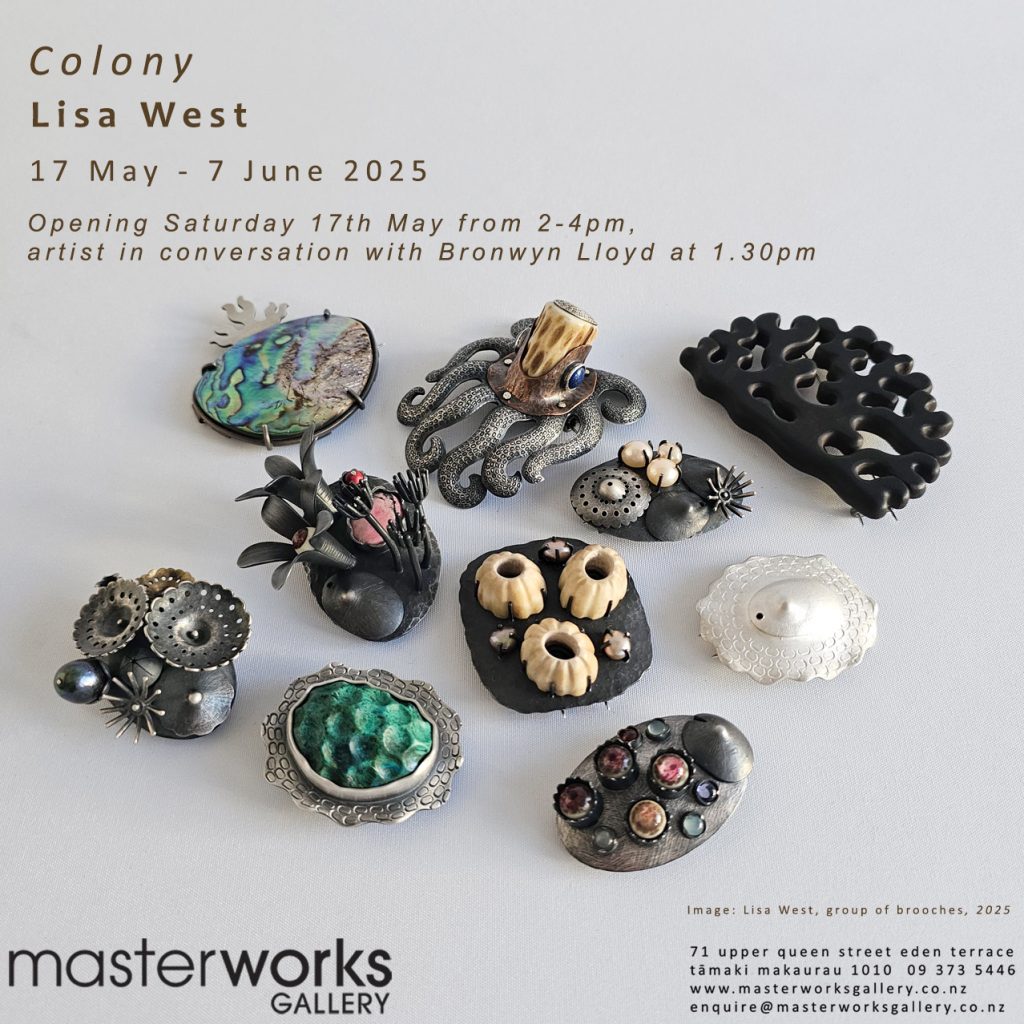
Colony


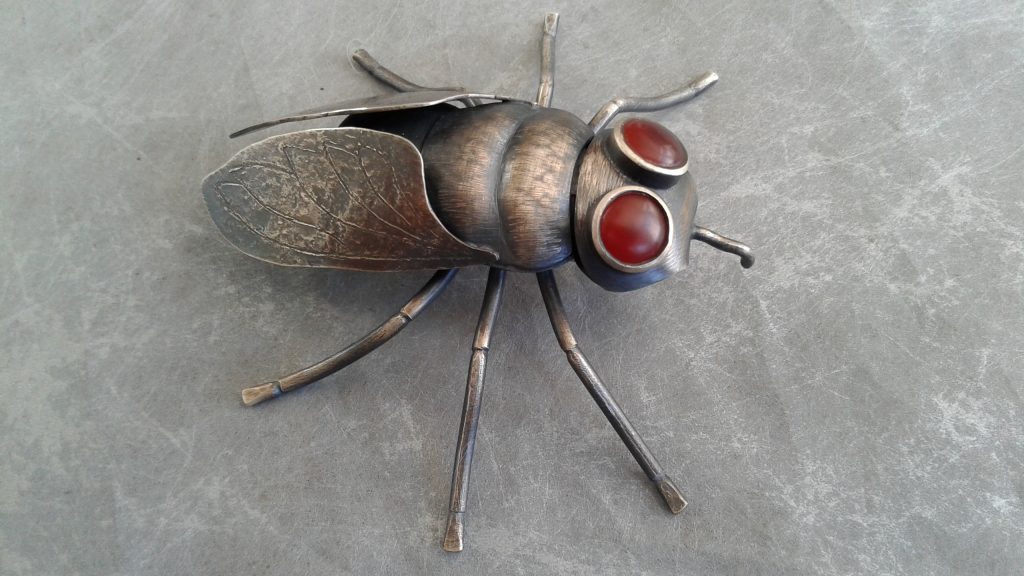

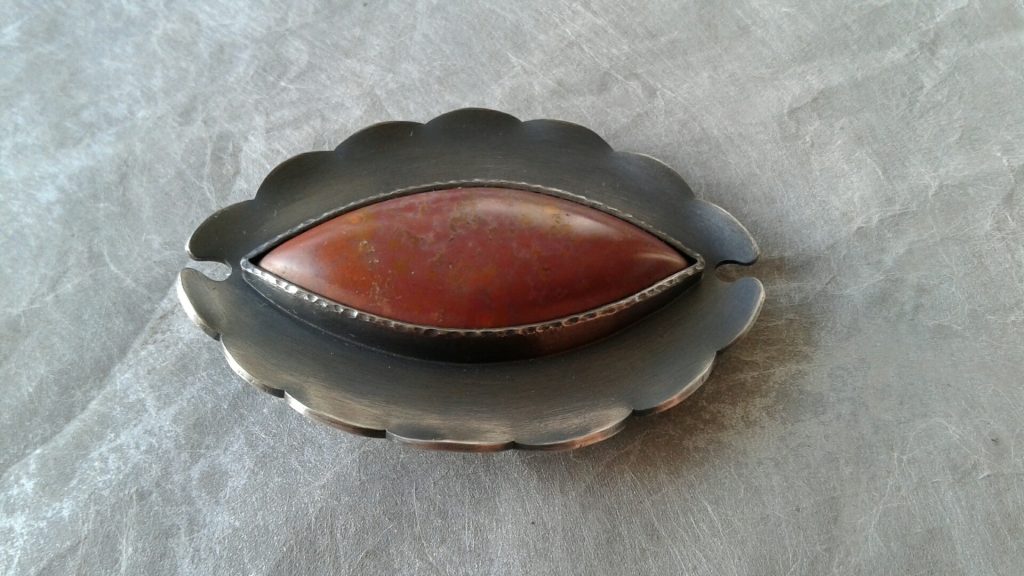
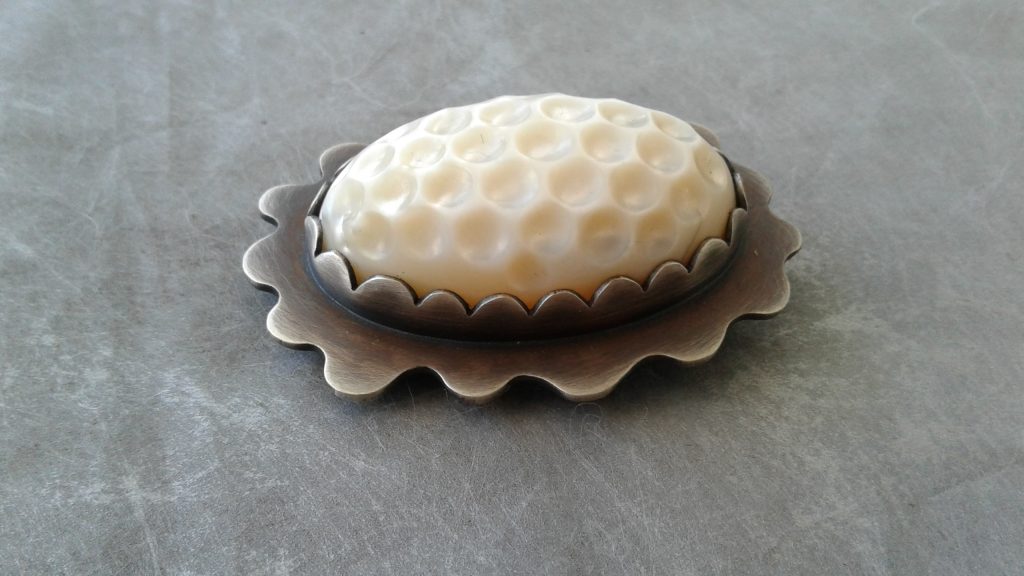
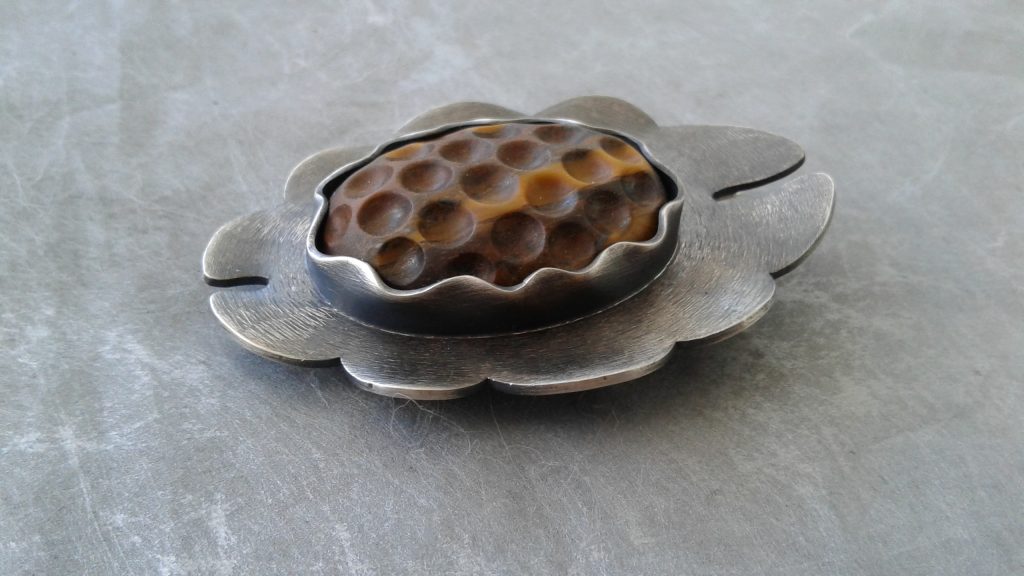
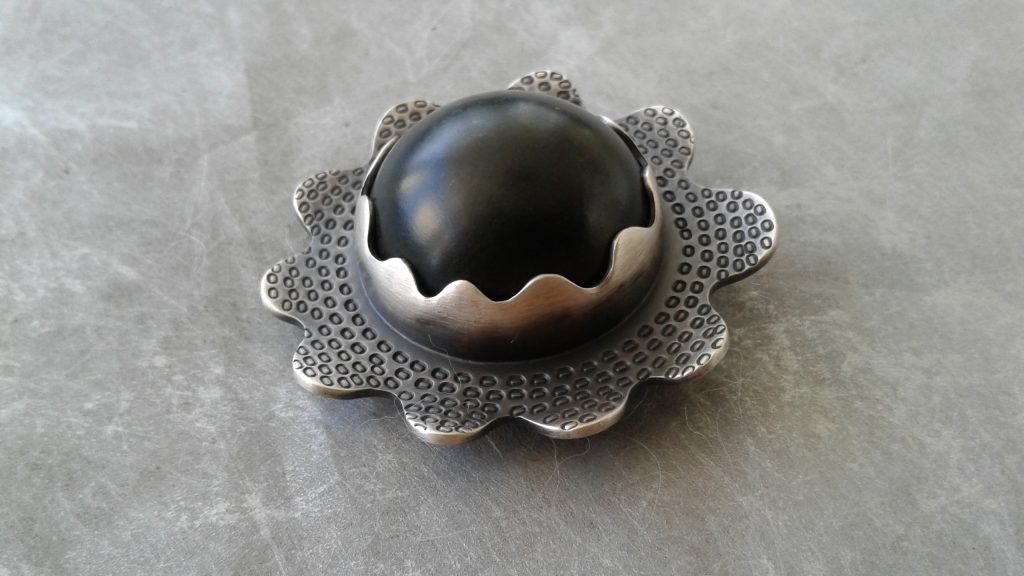
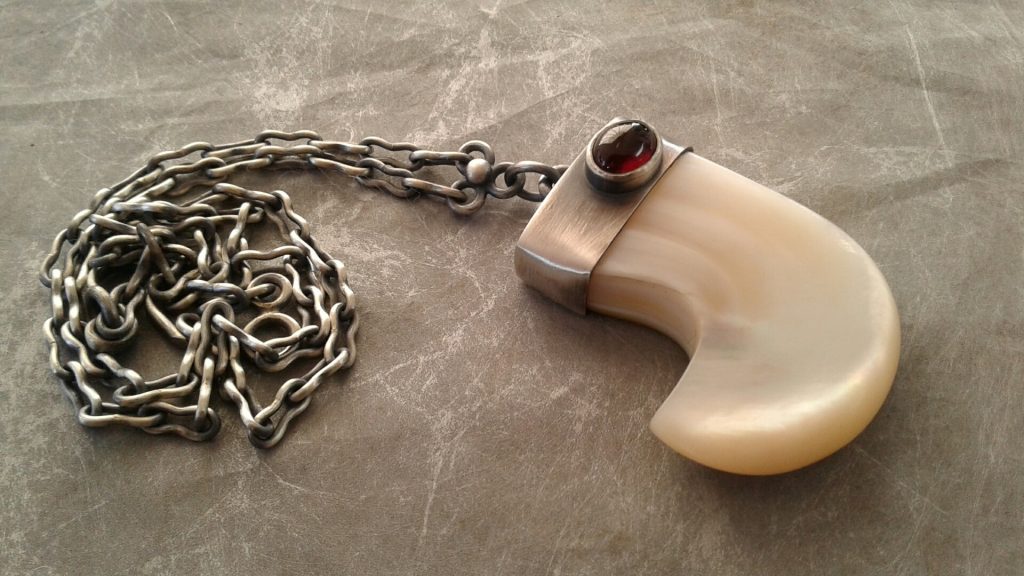
Maria Gloria de Bourgogne was born in Burgundy towards the end of the confusingly named Hundred Years War into the noble family of the Marquis de Bourgogne. A highly unattractive newborn; the midwife screamed, slapped her, and then crossed herself repeatedly. The oddly-shaped facial birthmark eventually faded, but the beetlebrow, fearsome squint, and jaw that jutted like the prow of a Viking longboat never did. If anything, these unlovely characteristics intensified as she grew older.
Icon of Maria Gloria de Bourgogne, silver/iolite
The last-born into a family of eight girls, four of whom were named Maria, her father quickly ascertained that Maria Gloria would not be a good marriageable proposition to any aging nobleman looking for a brood-mare to shore up his title and lands. She was ugly and opinionated, so her father determined she should also be educated. This would make her extremely unattractive to even the most repellent old man and would save her father the necessity of yet another expensive dowry. Let the church have her!
Alas, the church did not want her. Maria Gloria was absolutely fine with chastity, but unable to embrace the requisite virtues of poverty and obedience. She was returned to her dismayed family in less than a week; her education had not prepared her for the rigours of life in a nunnery. She could neither embroider or sew, the tasks traditionally allocated to the daughters from noble families. Her fluent Latin, comprehensive study of the Greek Classics and Philosophers, knowledge of Euclidian Geometry, and self-directed interest in metallurgy and medicine which pre-dated Paracelsus by a number of decades had no status in a place of feminine devotion to a masculine god. Her allergy to all things piscine on a Friday was her final undoing.
At the end of his tether and in a fit of hand-wringing pique her anguished father determined to send her into the service of his nemesis, Chancellor Nicholas Rolin. Rolin had come to favour as a peace negotiator between the French and the Burgundians. He was not a nobleman but he had been rewarded handsomely for his services to the Duchy of Burgundy. He was considerably wealthier than most of his noble counterparts at a time when most of the populace lived in miserable poverty, and consequently earned the envious emnity of his noble betters. Rolin had established a Hospice for the poor and indigent in Beaune, unusual for its time in that it was fiercely independent from the Church. Rolin insisted that all of his nurses were lay-sisters. They were all sourced from the middle and upper-middle classes and were not permitted to take nun’s vows whilst in service, though they were nominally expected to pledge to poverty, obedience and chastity. It was an honour to their grateful families for a girl to be accepted for nursing servitude…
Regretfully, an attitude of servitude and gratitude was unattainable by Maria Gloria. Her bedside manner was abominable, and her hospital corners worse. Pity the suffering terminal patient whose last earthly sight was the scowling visage of Maria Gloria… She found her lodgings unsalubrious, her uniform unflattering, and the simple yet nourishing food unpalatable. Her modest stipend she deemed risible. Her increasingly desperate father worn down by her incessant complaints determined to secretly incentivise Chancellor Rolin to progress Maria Gloria’s career in the manner she believed herself entitled to. In short, he gifted the hospice a modest parcel of prime grape-growing land in order to grease the path of his vile off-spring.
When Maria Gloria found herself in command of a modest but well-appointed apothecary complete with beakers and flasks for distillation and titration, razors and saws for letting and cutting, tools for cupping, annelids for leeching, fleams and clysters for all manner of painful indignities, restraining boards complete with straps and buckles, plus a selection of cauterising irons she believed it was because of her own extraordinary ability rather than the sacrifices of her dear Papa.
Actually, Maria Gloria was clever and able, but like many people of good fortune and privilege she was unable to see that her success was as much due to opportunities made available to her as her own adroitness. However, let us not dwell on Maria Gloria’s sociopathy, but instead celebrate her achievements… She proved very adept at the arts of distillation; her poppy and pinot potation was deemed a taste sensation and proved a highly effective somnambulant for both suffering patients and exhausted nurses, as well as being less fatal than her hemlock concoctions. Certainly Maria Gloria was not averse to tippling in her tinctures in the interests of experimentation when the need arose. The Hospice did not accept plague victims, lepers, or pregnant women as patients, but Maria Gloria had a very lucrative sideline in particular infusion of tanacetum vulgare, pulegium regium, and her father’s finest Burgundian pinot noir. This preparation was created with utmost care as Maria Gloria quickly learned to her mild discomfort that even small quantities of extract of pennyroyal cause failure of the liver and death, at which point the reality of an unwanted pregnancy becomes an irrelevancy. During Maria Gloria’s reign at Hospices de Beaune it was noted that Beaune had a remarkably low rate of birth. Her exploits in amateur surgery were less triumphant, but the survival rates from invasive incisions were inauspicious in 15th century France so I think it unjust to be overly punctilious. It was an uphill battle for the most conscientious of barber surgeons to overcome the threat of gangrenous humors when the only antiseptic available was an unappetising concoction of fresh urine and wine. A survivor of the surgery would likely die from the shock of wound cauterisation at any rate.
It will come as no surprise to readers of moral tales that Maria Gloria was eventually broken on the wheel of her own hubris… Increasingly arrogant and perhaps maddened by constant imbibing of her own potions she began to dabble in the darker arts. Believing herself impervious to accusations of witchcraft because of her nobleman Papa and because the church was so comprehensively excluded from the Hospice she embarked on a new line of side-products designed to further line her pocketbook. Word of Maria Gloria’s range of hallucinogenic unguents and salves spread faster than plague buboes. She devised philtres for the lovesick, elixirs for the heartbroken. I fear it is likely she was a purveyor of poisons for those wishing to cause harm, such was her lack of moral compass. When the buyers of illicit substances come knocking at your door the law is seldom far behind. Testimony has it that Maria Gloria grew increasingly anxious and paranoid.
No-one can say for certain what precipitated the distressing events of June 21 1460, but the facts indicate that a collection of nurses in the courtyard of the Hospices de Beaune heard a bloodcurdling shrieking coming from a second storey room. Alarmed, they all looked up in time to see the figure of Maria Gloria cartwheeling out of the window. In moments she had landed heavily and brokenly on the cobblestones in front of them, her brains leaking from an irreparably damaged skull. Eyes open wide, lips snarled in a terrified grimace, and legs akimbo, Maria Gloria was no lovelier in death than she had been in life. Some of the nurses swore they had heard her bawl “Possum volare!” as she left the window. This remained unverified, but if true it suggests that Maria Gloria may have been experimenting with ‘flying ointment’. It seems possible that she could have concocted an ointment extracted from henbane, hemlock, belladonna, or mandrake, muddled with base of fat and applied it to her nether regions. The hallucinogenic properties would have acted swiftly and lethally. Like many before her and many to follow, she believed she could fly…
It is very difficult to find further information about Maria Gloria de Bourgogne. There is no marked grave, I know, because I searched for it in vain when I visited Beaune. It’s likely she was buried in unconsecrated ground as a suicide and disowned in death by her surviving family members. Requiescat in pace.
St. Affable the Herbalist
St. Affable was a French Benedictine monk who practised herbalism in the early 15th century in the abbey situated upon the famed Mont St. Michel on the Normandy coast.
Icon of St. Affable the Herbalist, silver/garnet
He was an inadvertant innovator and pioneer in the herbal and metaphysical arts, not because he was a thoughtful intellect, but because he was a drug-addled congenital idiot with no understanding of consequences.
The discovery of clusters of panaeolus cyanescens glimmering palely in the dank recesses of the abbey cloisters led to an unfortunate mealtime incident which caused the other monks and Abbot to mistakenly believe the order was demon-possessed for a brief time, but judicious use by Affable of cannabis sativa as a gruel garnish in subsequent meals soon erased memory of the aforementioned incident.
He was the original practitioner of naked yoga, which quite rightly earned him the derision of his fellow monks. Stripping himself of his filthy habit he would sit cross-legged au naturel for hours on end in the lotus pose, believing he had attained some level of Nirvana when he was bathed in a golden liquid from the heavens, an amber benediction if you will. Cruelly, it seems his fellow monks may have chosen to ‘rain’ on his parade from the ramparts above.
He was the original proponent of the juiced orange enema as a complete cure for cancer, but was never able to definitively prove his hypothesis owing to the irritating and intermittent conflicts on the Iberian Peninsula where the oranges were grown.
More intriguing were his claims made for his beloved cannabis sativa. According to Affable it’s humble leaf cured scrofula, ergotism, syphilis, St. Vitus Dance, leprosy, typhoid, the plague; bubonic and others, diptheria, consumption, sweating sickness, various poxes, measles, scurvy, and ennui.
In fact, the only disease cannabis cured was ennui, which was seldom fatal in Medieval Europe and ironically the side effects of the ingestion of cannabis for ennui induced ennui in those tending to the needs of the ingestor. It rapidly became an oubliette of boredom and stupidity.
How did this dim-witted monk achieve sainthood?
I believe he supplied the Antipope Benedict XIII of Avignon with industrial quantities of cannabis sativa.
Affable was not saintly and his ‘miracles’ were no more than psilocybin induced delusions.
Extensive scholarly research indicates Affable was little more than a medieval purveyor of mean-ass skunk-weed, yet his ultimate reward was an undeserved sainthood.
Scholarship is divided, as always, on the origin of the Bat and Crown as the heraldry of the Kings of Aragon. After extensive research I attributed the presence of the humble order of chiroptera on the Aragonese coat of arms to King Jaume I the Conquerer 1208- 1276.
Bat & Crown Heraldic Brooch, silver/iolite
Jaume I played a pivotal part in the Reconquista on the Iberian Peninsula. He expanded the House of Aragon north to Languedoc, located in what is now the South of France, south to the Balearic Islands, and southwest to Valencia. He was a handsome virile man, unlike so many of his royal European counterparts, and had three wives and many mistresses, all of whom bore him many children. This eventually led to fratricidal conflict as he tried to be fair in inheritance to all of his sons, rather than just favouring the eldest as he should have done in order to ensure the untroubled continuation of the Kingdom. However, enough of Jaume’s confusing personal life…
Legend has it that Jaume was awoken early on the morning of the decisive battle for Valencia by a bat fluttering around inside his tent. I find it more likely that this compulsive wencher was awoken early by the feminine wiles of a young camp follower than a local variety of murcielago.
An excerpt from Jaume’s writings about the reconquest of Valencia in Llibre del Fets, or his Book of Deeds did reveal this, however:
“At another time the men of the Archbishop of Narbonne were skirmishing with those from inside, but the Archbishop’s men did not know the way of the Saracens, who on that occasion, as in others, fled from them to draw them nearer to the town. Perceiving that the enemy’s footmen were only retreating with that end, I sent my people a message not to pursue, or else the Saracens would do them great hurt.
They would not stay for my message; but I, fearing lest thirty or more of them should be killed by the Moors, went up to them on the same horse I was then riding, and made them draw back. As I was coming with the men, I perceived of a great fluttering above my standard, and happened to turn my head upwards in order to ascertain the cause. To my astonishment I saw a great black bat above it, and took it as a sign from God. At that very moment a Saracen cross-bowman shot at me, and hit me beside the sun-hood, and the shot struck me on the head, the bolt lighting near the forehead. It was God’s will it did not pass through the head, but the point of the arrow went half through it. In anger I struck the arrow so with my hand that I broke it: the blood came out down my face; I wiped it off with a mantle of “sendal” I had, and went away laughing, that the army might not take alarm. I then went and lay down in a tent, when all my face and eyes swelled, so that I could not see for the swelling of the eye on the wounded side. When the swelling in my face had gone down, I rode round the camp that the army might not be discouraged.”
I believe the latter tale to be more likely, because his body was exhumed in 1856 from it’s burial site in the Monastery of Poblet in Catalonia when some restoration work was urgently required, and photos of his mummified head clearly show a healed wound in the bone above his left eyebrow, exactly as described in his writings.
We can assume that something was looking out for Jaume the Conquerer, but maybe it wasn’t the ‘God’ he imagined. However, the symbolism of the incident evidently had a significant impact on him, and the bat was adopted to sit atop the Crown of Aragon. The image of the Bat and Crown can be seen extensively to this day all over Valencia, adorning all the civic buildings, and even the metal utilities covers in the footpaths.